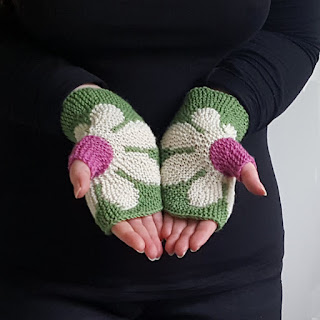About four years ago, I published a hat pattern that was based on the idea of a magic cast-on and knitting around it in a U-shape (U-Turn Hat) - as with many of my knitted accessories, it is knitted in fingering weight. Motivated by an online discussion with Angela from bestrickendes.de, I thought it might be a good idea to knit it in a thicker yarn. So the next time I went into a yarn store, I looked for some self-striping 6- or 8-ply yarn. I bought some Zwerger Opal Sweet Dreams (Colorway 9720 Sternentänzer, here's a link to the yarn's Ravelry page).
In this blogpost, I'll explain how I "adapted" the pattern to 6-ply yarn.
If you like that kind of construction, I have used a similar idea before for fingerless gloves (U-Turn Mitts) and slipppers (U-Turn Slippers).

Step 1: Check the general construction
The hat is knitted flat an in a U-shape around the first magic CO. Each row consists of a garter stitch part (ribbing - at the beginning and end of each row) and a semicircular bit around the turning point of the U. The slope is achieved by changing the number of increases and decreases. See schematic below.
 |
| Construction - click to enlarge |
First there are 4 decreases every 2nd row (section A), which basically creates a semicircle above the ribbing. Then only 3 increases (section B), then only 2 (section C), then only 1 (section D) and finally there will be a few rows without any increases at all (section E).
Once you've reached the middle of your piece, you will knit the same backwards, i.e. there will be decreases instead of increases. That means you start with no decreases (section F), then switch to 1 decrease every 2nd row (section G), then 2 decreases every 2nd row (section H), then 3 (section I) and finally 4 decreases every 2nd row (section J). Until there are only as many stitches left as in the original CO. The piece is finished with a three-needle BO.
To get the slope to fit around a standard head the pattern suggests that of the total number of rows necessary reach the middle of the piece should be divided as follows:
- about 1/3 for RS rows with 4 in/decreases
- about the same number for RS rows with 3 in/decreses
- about 1/6 for RS rows with 2 in/decreases
- divide the remaining rows equally into rows 1 in/decrease and no in/decrease.
Step 2: Knit a swatch
Yes, really. Even though I don't like swatching I knitted a small piece to find out how many rows I needed for the hat to fit around my head and how many stitches I needed to get my desired height of garter stitch ribbing.
Step 3: Calculate and distribute the rows
I decided that I wanted a ribbing about 6 cm high (13 stitches as per my swatch). For a quarter of the circumference of my head I calculated that I would need 27 ridges or 54 rows.
I then divided the 27 ridges into the sections as follows:
- section A /J: 9 ridges
- section B/I: 8 ridges
- section C/H: 5 ridges
- section D/G: 3 ridges
- section E/F: 2 ridges
- => total number of ridges 27
As you can see, the distribution of the sections is not as exact as suggested by the pattern. But since the resulting fabric (knitting) is quite stretchy, that doesn't matter.
Step 4: Knit
And while you're knitting, check and measure from time to time, if your calculations are correct and - if necessary - adapt.























